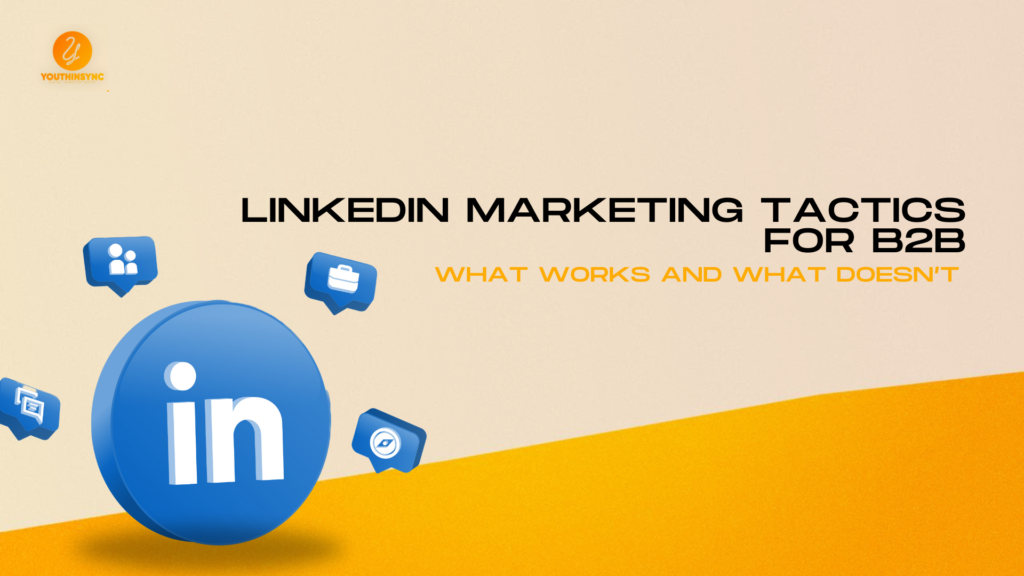Introduction
In today’s digital landscape, LinkedIn stands out as a premier platform for B2B marketing. With over 900 million members globally, LinkedIn provides a unique opportunity for businesses to connect with other professionals, share valuable content, and generate leads. However, not all LinkedIn marketing tactics are equally effective. This comprehensive guide explores the tactics that work and those that don’t, helping you optimize your LinkedIn strategy for B2B success.
Understanding LinkedIn’s Role in B2B Marketing
LinkedIn’s importance in B2B marketing cannot be overstated. Unlike other social media platforms primarily focused on B2C interactions, LinkedIn is designed for professionals. It’s a platform where decision-makers, industry experts, and business leaders congregate, making it the perfect environment for B2B engagement.
Statistics back up LinkedIn’s effectiveness in B2B marketing:
- 80% of B2B leads generated on social media come from LinkedIn.
- LinkedIn is 277% more effective at lead generation than Facebook and Twitter.
- 94% of B2B marketers use LinkedIn to distribute content.
These figures underscore LinkedIn’s unique position in the social media landscape. By leveraging the platform’s features correctly, businesses can significantly enhance their marketing efforts.
What Works in LinkedIn B2B Marketing
Optimized LinkedIn Profiles and Company Pages
Your LinkedIn profile and company page are the first impressions potential clients and partners will have of your business. Therefore, optimization is crucial. A well-crafted LinkedIn profile should include a professional photo, a compelling headline, and a detailed summary that highlights your expertise. For company pages, ensure all sections are complete, including a clear and concise description of your business, relevant keywords, and up-to-date contact information.
Tips for Optimizing LinkedIn Profiles and Pages:
- Use keywords related to your industry and services to improve visibility.
- Include a strong call-to-action (CTA) to guide visitors on the next steps.
- Regularly update your page with relevant content to keep it active and engaging.
Content Marketing on LinkedIn
Content is king on LinkedIn, and it plays a pivotal role in B2B marketing. To succeed, you must share content that resonates with your audience and positions your business as a thought leader. High-performing content on LinkedIn includes articles, industry insights, case studies, and video content.
Key Content Types for LinkedIn:
- Articles: In-depth articles on LinkedIn Pulse can drive engagement and establish authority.
- Posts: Short-form posts with actionable insights can spark conversations and increase visibility.
- Videos: Video content is highly engaging and can showcase your products, services, or company culture.
LinkedIn Pulse as a Tool for Content Distribution
LinkedIn Pulse is a publishing platform that allows you to share long-form content directly with your connections and followers. By regularly publishing articles on LinkedIn Pulse, you can expand your reach, enhance your credibility, and drive more traffic to your website.
LinkedIn Ads and Sponsored Content
Paid advertising on LinkedIn is an effective way to reach your target audience with precision. LinkedIn offers various ad formats, including Sponsored Content, Sponsored InMail, and Text Ads. Each format has its advantages, and the key to success lies in targeting the right audience.
Types of LinkedIn Ads:
- Sponsored Content: Promoted posts that appear in the LinkedIn feed, ideal for content promotion.
- Sponsored InMail: Direct messages sent to targeted LinkedIn users, perfect for personalized outreach.
- Text Ads: Simple ads that appear on the sidebar, useful for driving traffic to your website.
Tips for Effective LinkedIn Ads:
- Use clear and compelling visuals in Sponsored Content.
- Personalize Sponsored InMail messages to increase open rates.
- Regularly A/B test your ads to optimize performance.
Building and Engaging with a Professional Network
Networking is at the core of LinkedIn’s value proposition. To succeed in B2B marketing, you need to build and engage with a relevant network. This means connecting with potential clients, industry peers, and influencers who can help amplify your message.
Strategies for Growing Your Network:
- Connect with people you’ve met in professional settings, such as conferences or webinars.
- Join LinkedIn Groups relevant to your industry and participate in discussions.
- Engage with your connections by commenting on their posts and sharing valuable insights.
Importance of Personal Engagement and Messaging
While growing your network is important, engaging with it is crucial. Personalized messaging and regular interaction can help you build stronger relationships and increase your chances of converting connections into clients.
Utilizing LinkedIn Analytics
LinkedIn provides robust analytics tools that allow you to track your performance and make data-driven decisions. By monitoring key metrics, you can identify what’s working and adjust your strategy accordingly.
Key Metrics to Monitor:
- Profile Views: Indicates how often your profile is being viewed.
- Post Engagement: Measures likes, comments, and shares on your content.
- Follower Growth: Tracks the increase in followers over time.
What Doesn’t Work in LinkedIn B2B Marketing
Overly Promotional Content
One of the biggest mistakes businesses make on LinkedIn is sharing overly promotional content. Unlike other platforms, LinkedIn users expect value-driven content that offers insights or solves problems. Excessive promotion can lead to disengagement and a loss of credibility.
The Balance Between Promotion and Value
To avoid being too promotional, focus on creating content that educates, informs, and inspires your audience. For every promotional post, share multiple value-driven posts that demonstrate your expertise and provide actionable advice.
Ignoring the Importance of Personal Branding
Personal branding is as important as company branding on LinkedIn. Neglecting personal profiles can undermine your B2B marketing efforts. A weak personal brand can make it harder to build trust and credibility with potential clients.
Impact of Weak Personal Branding on B2B Efforts
A lack of personal branding can result in missed opportunities for networking and business development. Ensure that key team members have strong LinkedIn profiles that reflect their expertise and align with your company’s brand.
Misusing LinkedIn Ads
While LinkedIn Ads can be highly effective, they can also be costly if not executed correctly. Common pitfalls include poor targeting, irrelevant ad content, and inadequate budget management.
Examples
Failed LinkedIn ad campaigns often result from a lack of understanding of the platform’s unique audience. For example, targeting too broad an audience or using generic ad copy can lead to low engagement and wasted budget.
Neglecting Analytics and Data-Driven Decisions
Ignoring LinkedIn analytics is a surefire way to derail your marketing efforts. Without data, you’re essentially flying blind, making decisions based on assumptions rather than evidence.
The Dangers of Ignoring LinkedIn Analytics
Neglecting analytics can lead to poor decision-making, such as continuing with ineffective strategies or missing out on opportunities for improvement. Regularly reviewing your analytics ensures that your LinkedIn marketing remains on track and aligned with your business goals.
Case Studies: Successful vs. Unsuccessful LinkedIn B2B Campaigns
Successful Campaigns Successful LinkedIn B2B campaigns share common traits: clear objectives, targeted outreach, and value-driven content. For example, a B2B software company achieved a 50% increase in leads by focusing on thought leadership content and engaging with industry influencers.
Unsuccessful Campaigns On the flip side, unsuccessful campaigns often suffer from poor planning and execution. A notable example is a B2B firm that invested heavily in LinkedIn ads without properly defining its target audience, resulting in a low conversion rate and wasted budget.
Conclusion
LinkedIn offers immense potential for B2B marketing, but success requires a strategic approach. By focusing on what works—such as optimized profiles, content marketing, and targeted ads—you can enhance your LinkedIn strategy and achieve your business goals. Conversely, avoiding common pitfalls like overly promotional content and neglecting analytics will help you stay on track.

